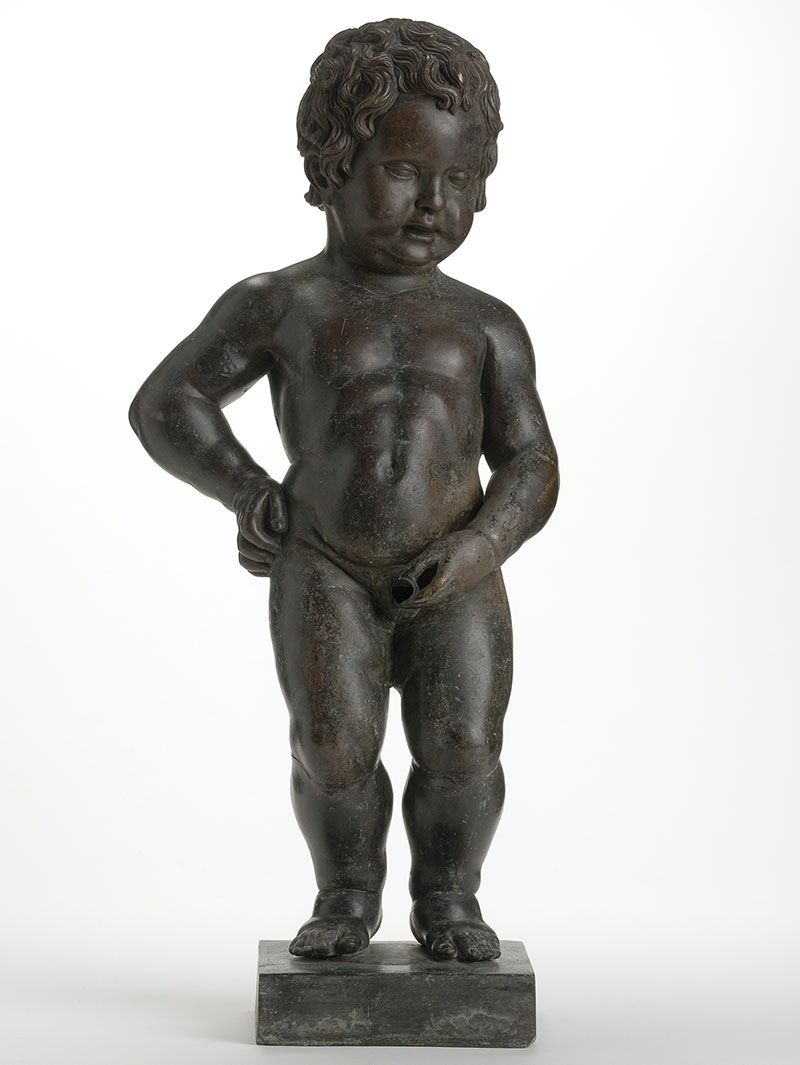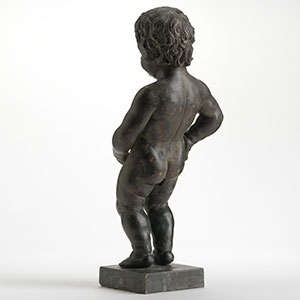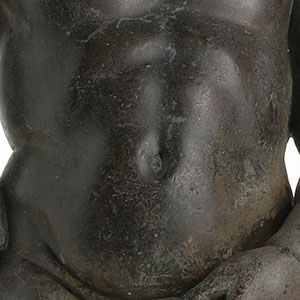
Bronze sculpture. Jérôme Duquesnoy the Elder. 1619-1620
This is the most famous symbol of Brussels. It is the original statuette created by Jérôme Duquesnoy the Elder, commissioned by the Brussels authorities in 1619. It once stood as a working fountain on the corner of two streets not far from the Grand Place. For security reasons, it has now been replaced by an identical copy.
The baroque version of a much older sculpture
The colloquial name “Manneken-Pis” given to the statue by the people of Brussels in their local Dutch simply means “little boy urinating”. The first version of the statue, by an unknown sculptor, existed back in 1451, as evidenced by a document relating to the water network that supplied a whole series of fountains erected by the City of Brussels.
 The first sculpture was replaced in 1620 by a new, baroque-style version that you now see before you. Standing 55.5 cm tall, Manneken-Pis is turning his head, lifting his feet off the ground and leaning backwards, while relieving himself holding his member in his left hand.
The first sculpture was replaced in 1620 by a new, baroque-style version that you now see before you. Standing 55.5 cm tall, Manneken-Pis is turning his head, lifting his feet off the ground and leaning backwards, while relieving himself holding his member in his left hand.
A urinating putto
 On closer inspection, the plump-cheeked little boy sports a rounded belly and an incredibly muscular torso. This is the unmistakable sign that this is not, in fact, a representation of an actual child, but a “putto” - The Italian term in art history that denotes the figure of a nude and chubby- faced little boy, sometimes with wings, who personifies an innocent young spirit. With its origins in the ancient representation of Cupid, the god of love, from the 15th century onwards this theme was reinterpreted to reflect contemporary tastes. There are many different interpretations, including the urinating putto which already existed in classical times and made a comeback between the 15th and 18th centuries. During this period, this type of carved or painted depiction is found in various locations in Europe. Presumably, the Manneken-Pis has its origins in this theme and the medieval taste for unusual fountains.
On closer inspection, the plump-cheeked little boy sports a rounded belly and an incredibly muscular torso. This is the unmistakable sign that this is not, in fact, a representation of an actual child, but a “putto” - The Italian term in art history that denotes the figure of a nude and chubby- faced little boy, sometimes with wings, who personifies an innocent young spirit. With its origins in the ancient representation of Cupid, the god of love, from the 15th century onwards this theme was reinterpreted to reflect contemporary tastes. There are many different interpretations, including the urinating putto which already existed in classical times and made a comeback between the 15th and 18th centuries. During this period, this type of carved or painted depiction is found in various locations in Europe. Presumably, the Manneken-Pis has its origins in this theme and the medieval taste for unusual fountains.
The symbol of the people of Brussels
Then as now, Manneken-Pis’ humorous charm wins people over. Over the years, other traits have been attributed to him which the people of Brussels like to believe embody their spirit. He is variously seen as an irreverent little boy, a champion of freedom, unperturbed by other people’s opinions. In 1695, a satirical text makes him the mouthpiece of the people of Brussels who are castigating the King of France Louis XIV for being responsible for the dreadful bombardment of their city. By this time, Manneken-Pis has already achieved fame way beyond the confines of the city. A whole series of legends created during the 19th century further enhance his aura. He is still used today in caricatures or advertising to represent Brussels and the spirit of its residents.
Now an icon, he also elicits interpretations by contemporary artists.
An eventful history
The statuette has been the subject of several kidnap attempts. In 1867, it had to be skilfully restored after having being broken into several pieces and was given a new, thicker base. The visible mark below his knees was caused when the statue was abducted in 1965. On that occasion, the sculpture was broken in two: the feet and calves remained attached to the base whilst the rest of the body was taken by the thief. Once it was recovered, the statuette was soldered back together and housed in the safety of the museum.
Next step
Turn back to discover the display cases illustrating how important Manneken-Pis has become in the hearts of the people of Brussels.




